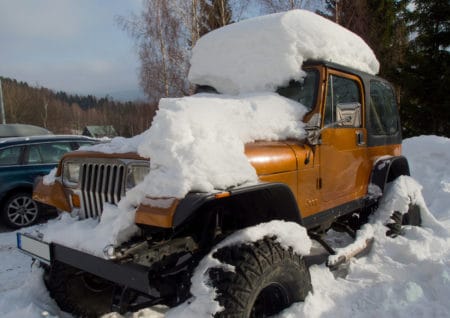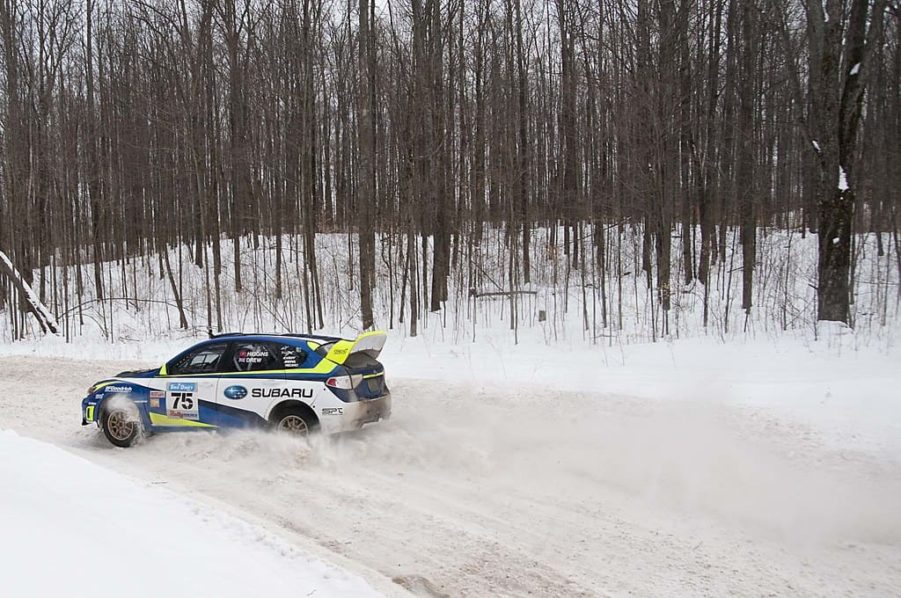Driving in the snow is an experience we all either hate or love. With all the slipping and sliding that the low-traction environment provides, is it safe to try to drift in?
Snow drifting is much less harmful to your car than regular drifting is. However, there are new sets of risks that come with sliding in the snow, such as limited correctional maneuverability and driveline shock.
That’s the short answer of it, just be careful where you do it, go slow, and don’t hit anything. Those aren’t the only dangers, though. With snow drifting, depending on your drivetrain, can come various, significantly worse issues. Even in AWD, your car can suffer serious damage if you aren’t careful.
If you take one thing from this article, let it be this: bring warm clothes, a fully charged phone, certainly a power bank/charger for your phone too, and make sure you have good signal where you’ll be drifting. A couple granola bars wouldn’t hurt either. Be prepared to be stranded for four hours or more, as you don’t know how long it will take for help to arrive. Leave these in your center console or secured in the passenger’s seat, somewhere you can access if you’re injured or stuck in the driver’s seat. If you crunch your driver’s side door, you might be trapped in your car, and items the trunk won’t help you then.
Risks of FWD Snow “Drifting”
 While the grip in a FWD car is noticeably better than in a RWD car in the snow, that isn’t a Get Out Of Jail Free card. It is most certainly the hardest of the three drivetrains to control. RWD is the easiest to lose control of. Using the handbrake is a very common way to slide a FWD car, but also can cause significant damage to your car, including:
While the grip in a FWD car is noticeably better than in a RWD car in the snow, that isn’t a Get Out Of Jail Free card. It is most certainly the hardest of the three drivetrains to control. RWD is the easiest to lose control of. Using the handbrake is a very common way to slide a FWD car, but also can cause significant damage to your car, including:
- Flat-spotted tires
- Skidding into a curb
- Stretching your e-brake cable
- Snapping your e-brake cable
- Unbinding your e-brake pad from the shoe and locking your hub (depending on the age of your e-brake pads)
- Your e-brake getting stuck (more of a risk if you haven’t used it in a while)
Using the handbrake also makes your car incredibly difficult to control. While the front wheels are pulling, the rears are just tracking behind, and can easily snap out and hit curbs, other cars, lamp posts, etc.
The biggest risk of sliding a FWD car is easily the uncanny ways the car reacts to input. In RWD and AWD cars, one input means one output. If you give too much gas in RWD, the back end will come around. If you countersteer too hard, the rear end will flick the other way. In AWD, you turn the way you want to go, and push the gas. In FWD, though, there is no guaranteed response for any given input. Every car will respond differently, so know yours well.
Risks of RWD Snow Drifting
 It should come as no surprise to anyone that RWD is the lowest grip in the snow. This is especially prevalent while drifting. While drifting in RWD, the car is very slow to respond to inputs. This is both good and bad for new drifters, as the slow response will allow for mistakes with the clutch and gearshift.
It should come as no surprise to anyone that RWD is the lowest grip in the snow. This is especially prevalent while drifting. While drifting in RWD, the car is very slow to respond to inputs. This is both good and bad for new drifters, as the slow response will allow for mistakes with the clutch and gearshift.
However, once you over-throttle, and the back end starts to come around, there is very little that can be done to stop it. You will almost assuredly end up skidding backwards, and pray you won’t hit anything. Be light with your throttle inputs, and you shouldn’t experience this issue.
Be sure to inspect the area you’ll be drifting in, make sure there are no surprise curbs or parking bumpers hiding under the snow. Running into one of these is almost a sure ticket to snapping control arms and jamming axles into differentials. Also watch for potholes, as you could easily bend a rim or pop a tire skidding into one of those.
Important Note!
Just because there’s snow on the ground doesn’t mean every car will slide! Having an open differential will still inhibit your drifting, even in the snow. It’s incredibly dangerous to be sliding with an open differential in the first place, adding snow to the equation makes it that much worse!
Risks of Quattro “AWD” Drifting
 Before we talk about drifting it, we need to address the elephant in the room. Audi’s Quattro system is NOT All-wheel drive. It is a poor example of a situational 4WD system. In essence, Quattro is FWD with a temporary rear-wheel assist. However, it will feel closer to AWD than FWD, as long as your drivetrain is activating properly.
Before we talk about drifting it, we need to address the elephant in the room. Audi’s Quattro system is NOT All-wheel drive. It is a poor example of a situational 4WD system. In essence, Quattro is FWD with a temporary rear-wheel assist. However, it will feel closer to AWD than FWD, as long as your drivetrain is activating properly.
The engagement of the rear wheels on and off while drifting could cause damage, and we know all too well that Audi isn’t the cheapest brand to repair. Another issue is that the rear wheels could just stop engaging while you’re mid-skid. Then you’re switching from AWD to FWD instantaneously, and losing most of your control of the car. Very, very bad scenario to be in.
If you want my opinion on sliding a Quattro, here it is. Don’t.
Risks of Real AWD Drifting
(Excuse the Eurobeat music, and I don’t own this video)
Subaru, BMW, MINI, these companies use real AWD systems, with three differentials. These systems are infinitely more predictable, reliable, and safe. In the snow, they handle exactly as an AWD car should, pulling consistently towards the apex of the turn. In sliding, these systems are right up near the top (second to only 4WD), with a little flexibility and forgiveness. Given that they have three differentials, that means that torque is split to all four wheels somewhat evenly. However, this also leads to a couple downsides.
Pulling the e-brake in an AWD car is a sure-fire way to blow up your center differential. When power is being sent to both the front and rear wheels, locking just the rears causes a large amount of shock. The spider gears in the differential have to go from stationary to turning as fast as the wheels were going. A differential can only do that so many times before it shears a gear off. Another scenario that can cause a very similar outcome is hitting a dry patch of pavement with one or more wheels. That wheel stops turning instantly, and the torque that was being sent to spin the wheel is now lashing through the center and rear differentials, while also trying to lurch the car forward. This can cause component failure, as well as loss of control.
In the case of the Subaru WRX, also keep in mind those transmissions are the mechanic’s equivalent of glass. If you breathe on them too hard, you might shear a gear. Make sure you’re listening to the sounds your car makes, and if you hear something funky, stop immediately.
Risks of 4WD Drifting

This is for those of us who drive off-road trucks, or some SUVs, where we have locking differentials (or another form of 4WD). These cars are incredibly similar to AWD, but have one major difference in their driving risks. While the AWD cars are prone to breaking their differentials when they hit dry pavement, 4WD cars will lurch forwards and possibly snap axles.
The locked differentials don’t allow for the driveline to have much, if any, lash. The spinning wheel that finds pavement will continue to spin, and throw the car forward in the process.
4WD drifting allows you to gas the car with complete control over every wheel. This even torque distribution, combined with the locking differentials, provide not only the safest way to play, but one of the safest road-going vehicles in the snow as well.
If you’re looking to have some powder-ey fun this season, and tear up a local parking lot, I would whole-heartedly recommend getting something 4WD. Almost all Jeep products have this system in them.

